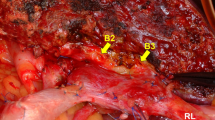Abstract
Purpose
The middle hepatic vein (MHV) is an important landmark in anatomical hemihepatectomy. The proximity between the MHV and the hilar plate was suspected to be associated with tumor exposure during left hemihepatectomy for advanced perihilar cholangiocarcinoma and is reported to facilitate a dorsal approach to the MHV during laparoscopic hemihepatectomy. However, the precise distance between these locations is unknown.
Methods
To investigate the “accurate and normal” distance between the MHV and the hilar plate, the present study focused on patients who presented without perihilar tumor. One hundred and sixty-eight consecutive patients who underwent pancreatoduodenectomy were included. Retrospective radiological measurement was performed using preoperative multi-detector row CT. The optimized CT slices perpendicular to the MHV were made using the multiplanar reconstruction technique. The shortest distance between the MHV and the hilar plate was measured on the left and right sides on the perpendicular slices. The diameters of the left and right hepatic ducts were also measured.
Results
The distance was 9.0 mm (1.9–20.0 mm) on the left side and 11.3 mm (2.3–21.8) on the right side (p < 0.001). The distance on the left side was < 10 mm in 60% of patients (n = 100). Only one-third of patients (n = 55) had a distance of ≥ 10 mm on both sides. As the hepatic ducts became more dilated, the distance from the MHV to the hilar plate became shorter.
Conclusion
The MHV was located in close proximity to the hepatic hilus, especially on the left side.






Similar content being viewed by others
Availability of data and materials
The datasets during and/or analyzed during the current study are available from the corresponding author on reasonable request.
References
Ogiso S, Okuno M, Shindoh J, Sakamoto Y, Mizuno T, Araki K et al (2019) Conceptual framework of middle hepatic vein anatomy as a roadmap for safe right hepatectomy. HPB (Oxford) 21(1):43–50
Ueno M, Hayami S, Nakamura M, Yamaue H (2020) Laparoscopic-specific procedure using dorsal approach to the middle hepatic vein in laparoscopic left hemihepatectomy. Surg Oncol 35:139–140
Yu DC, Wu XY, Sun XT, Ding YT (2018) Glissonian approach combined with major hepatic vein first for laparoscopic anatomic hepatectomy. Hepatobiliary Pancreat Dis Int 17(4):316–322
Okuda Y, Honda G, Kurata M, Kobayashi S, Sakamoto K (2014) Dorsal approach to the middle hepatic vein in laparoscopic left hemihepatectomy. J Am Coll Surg 219(2):e1-4
Otsuka S, Mizuno T, Yamaguchi J, Onoe S, Watanabe N, Shimoyama Y, et al (2021) Efficacy of extended modification in left hemihepatectomy for advanced perihilar cholangiocarcinoma: comparison between H12345’8’-B-MHV and H1234-B. Ann Surg. Online ahead of print
Kawarada Y, Das BC, Taoka H (2000) Anatomy of the hepatic hilar area: the plate system. J Hepatobiliary Pancreat Surg 7(6):580–586
Nimura Y, Hayakawa N, Kamiya J, Kondo S, Shionoya S (1990) Hepatic segmentectomy with caudate lobe resection for bile duct carcinoma of the hepatic hilus. World J Surg 14(4):535–543 (discussion 44)
Sugiura T, Okamura Y, Ito T, Yamamoto Y, Ashida R, Ohgi K, et al (2018) Left hepatectomy with combined resection and reconstruction of right hepatic artery for bismuth type I and II perihilar cholangiocarcinoma. World J Surg 43(3):894–901
Shinohara K, Ebata T, Shimoyama Y, Mizuno T, Yokoyama Y, Yamaguchi J et al (2021) A study on radial margin status in resected perihilar cholangiocarcinoma. Ann Surg 273(3):572–578
Watanabe N, Ebata T, Yokoyama Y, Igami T, Sugawara G, Mizuno T et al (2017) Anatomic features of independent right posterior portal vein variants: implications for left hepatic trisectionectomy. Surgery 161(2):347–354
Tani K, Shindoh J, Akamatsu N, Arita J, Kaneko J, Sakamoto Y et al (2016) Venous drainage map of the liver for complex hepatobiliary surgery and liver transplantation. HPB (Oxford) 18(12):1031–1038
Pamecha V, Gurusamy KS, Sharma D, Davidson BR (2009) Techniques for liver parenchymal transection: a meta-analysis of randomized controlled trials. HPB (Oxford) 11(4):275–281
Fan ST, Lai EC, Lo CM, Chu KM, Liu CL, Wong J (1996) Hepatectomy with an ultrasonic dissector for hepatocellular carcinoma. Br J Surg 83(1):117–120
Makuuchi M, Hasegawa H, Yamazaki S (1985) Ultrasonically guided subsegmentectomy. Surg Gynecol Obstetrics 161(4):346–350
Ikeyama T, Nagino M, Oda K, Ebata T, Nishio H, Nimura Y (2007) Surgical approach to bismuth type I and II hilar cholangiocarcinomas: audit of 54 consecutive cases. Ann Surg 246(6):1052–1057
Funding
There were no grants or other financial support for this study.
Author information
Authors and Affiliations
Contributions
Study conception and design: SO, TS. Acquisition of data: SO, TA. Analysis and interpretation of data: SO, TS. Drafting of manuscript: SO. Critical revision: all authors.
Corresponding author
Ethics declarations
Conflict of interest
All authors declare no conflicts of interest in association with the present study.
Ethical approval
This study was approved by the Human Research Review Committee of Shizuoka Cancer Center (approval number 2019-0184).
Consent for publication
Information in the submission is anonymized and the submission does not include images that may identify the person.
Additional information
Publisher's Note
Springer Nature remains neutral with regard to jurisdictional claims in published maps and institutional affiliations.
Supplementary Information
Below is the link to the electronic supplementary material.
276_2022_3050_MOESM1_ESM.tif
Supplementary file1 Schmea of the angle of the perpendicular slice (right anterior oblique 61.5° and caudal 34.8°, [median]) (TIF 565 KB)
Rights and permissions
Springer Nature or its licensor (e.g. a society or other partner) holds exclusive rights to this article under a publishing agreement with the author(s) or other rightsholder(s); author self-archiving of the accepted manuscript version of this article is solely governed by the terms of such publishing agreement and applicable law.
About this article
Cite this article
Otsuka, S., Sugiura, T., Okamura, Y. et al. The proximity of the middle hepatic vein to the hepatic hilus: a retrospective radiological study. Surg Radiol Anat 45, 65–71 (2023). https://doi.org/10.1007/s00276-022-03050-2
Received:
Accepted:
Published:
Issue Date:
DOI: https://doi.org/10.1007/s00276-022-03050-2




